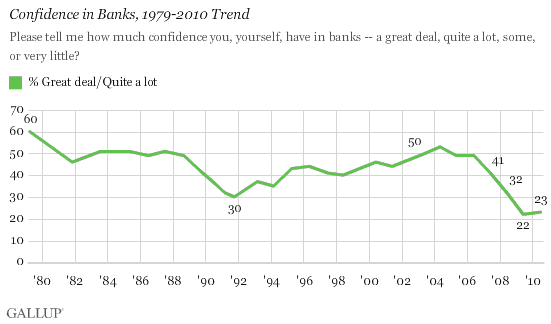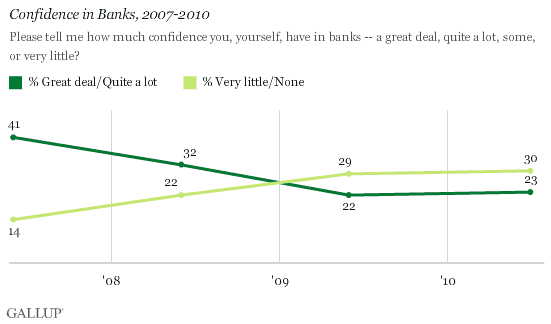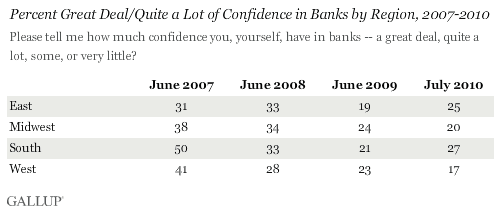PRINCETON, NJ -- The percentage of Americans saying they have a "great deal" or "quite a lot" of confidence in U.S. banks is at 23% this year -- essentially unchanged from 22% last year, and far below the pre-recession level of 41% in June 2007.

For the second year in a row, the percentage of Americans expressing very little or no confidence in U.S. banks exceeds the percentage expressing a great deal or quite a lot of confidence. This was not the case as recently as June 2007, before the recession began, and even June 2008, just prior to the financial crisis later that year.

Confidence Down in All Regions From Pre-Crisis Levels
The degree of confidence in banks has fallen in all regions of the country compared with the pre-recession/financial crisis days of 2007. The difference between then and 2010 shows the degree to which confidence is recovering in various parts of the nation. The largest decline is in the West, probably reflecting the continued problems in the housing sector in many Western states. The smallest is in the East -- but this includes an improvement from the financial crisis days of 2009 -- even as confidence levels in the West continued to decline.

Confidence in U.S. Banks Remains Fragile
As Europe struggles with its bank "stress tests," U.S. banks can take some solace in the success of their own tests of a little more than a year ago. In this regard, Federal Reserve Board Chairman Ben Bernanke told the Senate Committee on Banking, Housing, and Urban Affairs on Wednesday that, "Like financial conditions generally, the state of the U.S. banking system has also improved significantly since the worst of the crisis. Loss rates on most types of loans seem to be peaking, and, in the aggregate, bank capital ratios have risen to new highs."
On the other hand, the Treasury, the Federal Reserve, and banking regulators still have a challenge ahead of them. Bernanke also noted that "many banks continue to have a large volume of troubled loans on their books, and bank lending standards remain tight." Further, Gallup's polling shows Americans' confidence in U.S. banks is stabilizing, although it has done so at historically low levels. Americans still have higher confidence levels in banks than in Congress, HMOs, big business, and organized labor; however, banks trail small business, the medical system, newspapers, and more.
In sum, these results suggest that much needs to be done to restore Americans' trust in the U.S. banking system. For example, this poll was taken prior to the passage and signing of the Wall Street reform legislation. The politics surrounding that legislative effort as it worked its way through Congress probably did not help build confidence in U.S. banks. It remains to be seen whether the regulatory decisions that follow will do more to build confidence in the U.S. banking system than hurt it.
The U.S. needs a healthy financial system to achieve a sustainable economic recovery going forward. While it will take time, restoring Americans' confidence in U.S. banks is an essential element in achieving that goal.
Results for this Gallup poll are based on telephone interviews conducted July 8-11, 2010, with a random sample of 1,020 adults, aged 18 and older, living in the continental U.S., selected using random-digit-dial sampling.
For results based on the total sample of national adults, one can say with 95% confidence that the maximum margin of sampling error is ±4 percentage points.
Interviews are conducted with respondents on landline telephones (for respondents with a landline telephone) and cellular phones (for respondents who are cell phone-only). Each sample includes a minimum quota of 150 cell phone-only respondents and 850 landline respondents, with additional minimum quotas among landline respondents for gender within region. Landline respondents are chosen at random within each household on the basis of which member had the most recent birthday.
Samples are weighted by gender, age, race, education, region, and phone lines. Demographic weighting targets are based on the March 2009 Current Population Survey figures for the aged 18 and older non-institutionalized population living in continental U.S. telephone households. All reported margins of sampling error include the computed design effects for weighting and sample design.
In addition to sampling error, question wording and practical difficulties in conducting surveys can introduce error or bias into the findings of public opinion polls.
View methodology, full question results, and trend data.
For more details on Gallup's polling methodology, visit https://www.gallup.com/.
